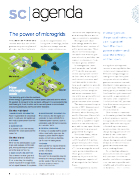SC |agenda The power of microgrids the nation are experimenting with microgrids as a way to improve service to members. Microgrids are small- scale energy networks best described as mini versions of utility power systems. These smaller networks incorpo- rate additional ways to gen- erate electricity, and they can connect or disconnect from the main grid as needed. In emergencies, these local networks can “island off” from the main power system and operate entirely on their own. A microgrid’s local electricity sources and load-management systems then work together to provide backup power to critical infra- structure, such as hospitals and water-treatment facili- ties, while also giving affected communities the ability to quickly recover after a storm. The hurricanes and tropical storms of 2017 demonstrated the value of microgrids. In Houston, where ooding cre- ated by Hurricane Harvey left hundreds of thousands with- out power, a number of super- markets in the affected area were able to stay open, thanks to electricity from a natural gas-powered microgrid. Hurricane Sandy, which hit the northeastern U.S. in 2012 and left 8.5 million people without power, was a catalyst for the construction of 35 new microgrids, accord- ing to greentechmedia.com. These grids currently make up 33 percent of the 2,045-megawatt capacity of all microgrids in the United States. Developments in battery In emergencies, these local networks can ‘island o ’ from the main power system and operate entirely on their own. storage have also spurred interest in microgrids for day- to-day energy management. Effective energy-storage sys- tems give co-ops the option to capture electricity when generation costs are low and distribute it when generation costs are high. This is the op- erating principle behind North Carolina’s rst grid-connected microgrid— a partnership of the state’s G&T cooperative, North Carolina EMC, and the local distribution cooperative, Tideland EMC— serving Ocracoke Island. This system is connected to the main grid and includes a diesel generator, battery storage and photovoltaic solar panels. When the microgrid is hooked up to the main power system, the batteries charge during periods of low demand, like in the early hours of the day, and dis- charge during periods of peak demand, or when everyone gets home from work and starts cooking dinner. As technology advances and costs decline, microgrids will continue to evolve as another tool electric coopera- tives can use to provide safe, reliable and affordable power to members. — KALEY LOCKWOOD THE AMERICAN POWER GRID is often hailed as one of the greatest engineering feats of all time, but there’s always Mainland How microgrids work room for improvement. Uti- lizing new technology, includ- ing battery-storage systems, electric cooperatives across The electricity grid is like the mainland, where energy is generated at a central power plant and sent to where it’s needed. A microgrid is like an island—although it is connected to the traditional grid, it can function on its own and power a concentrated area during blackouts, storms and other disasters. On the mainland 1 MAIN POWER GENERATOR Power is generated at a baseload plant. In daily use, microgrids can help reduce peak demand on the main grid. 2 SUBSTATION A substation is the intermediary between the power plant and the consumer. On the island 3 STORMS When storms and disasters cause large-scale outages on the main grid, microgrids keep the power on to the local community. 4 MAIN COUPLING SWITCH This is where the main grid and microgrid connect or disconnect. On a normal day, the coupling switch ensures that voltage levels remain equal between the systems. 5 INDEPENDENT GENERATION When needed, the microgrid can generate its own electricity from traditional power sources, such as generators, and alternative sources, such as solar farms. 6 CRITICAL SERVICES A microgrid is usually built to power critical community resources like hospitals, police and re depart- ments, and schools so that they can function in emergencies. 7 HOMES Individual homes may be linked to the microgrid, but are usually low on the priority list. 8 BUSINESSES Key commercial properties may be linked to the microgrid depending on the needs of the community. SOURCE: AMERICAN PUBLIC POWER ASSOCIATION 6 SOUTH CAROLINA LIVING | FEBRUARY 2018 | SCLIVING.COOP Island
